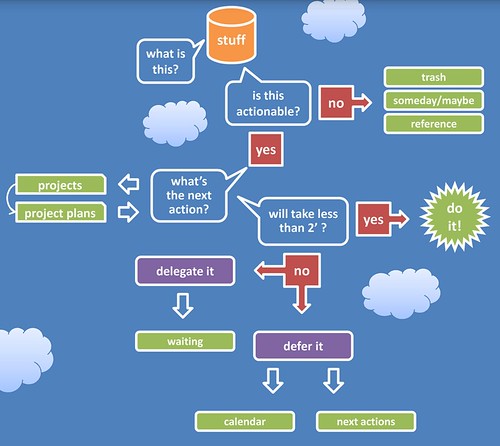Why "To Do" Lists Didn't Work Until GTD
So now comes the inevitable question: GTD is just keeping lists?
Um… Yes. And no.
Before I started using David Allen’s Getting Things Done methodology for personal productivity, I had made plenty of “to do” lists. And they didn’t really help. And, in some cases, the “to do” lists even sank me deeper into paralysis and procrastination. What was wrong with my “to do” lists?
The first problem with my previous “to do” lists was how incomplete they were.
I would only list 5-10 priorities I needed to do. Obviously there was a ton more of stuff that I needed to (or could) get done. But the lists weren’t based on a ubiquitous capture - everything in my life on lists.
The first major genius of GTD Lists is that they’re based on a ubiquitous capture.
The second problem with my previous “to do” lists was that they weren’t “Next Action Lists.” My list would look like this:
- Train Bob on CD Process
- Sermon
- Pick up dry cleaning
- Repair Roof
- Call babysitter
As you can see, a couple of these are Next Actions (”pick up dry cleaning” and “call babysitter”). But most of them are Projects (multi-step processes). And strictly speaking, you can’t do a Project. You can only do a Next Action related to the Project (edging that project toward completion).
So my list says “Sermon.” And I think I know what that means… But if I haven’t defined what my next physical action is, I think of the whole blessed thing that has to get done. And I’m paralyzed by the sheer magnitude. If I haven’t defined a next action, I can’t take a next action.
I need to repair my roof. But where do I start? If I haven’t defined a next action, I don’t know how to repair my roof. So I spend 30 seconds thinking… What is the next action I need to take to move this Project along? I guess I need to get a roofer recommendation from my friend Harold. So calling Harold is my next step.
So keeping your Project List separate from your Next Action List is the second major genius of GTD Lists.
The third problem with my previous “to do” lists was that I never looked at my list at the right time.
I would have home things and work things and store things and phone things and computer things all on the same list.
GTD teaches us to keep “contextualized” Next Action Lists. This way, I only look at the lists that are relevant to the context I find myself in. So I keep several different lists:
@Agendas
@Anywhere
@Call
@Computer
@Errands
@Home
@Office
@Prayer
@Reading
Waiting For
Borrowing
Lent Out
Projects
Someday/Maybe
Believe it or not, I actually have things on every one of these lists. My entire life is on lists. Some of the lists (waiting for, borrowing, lent out, someday/maybe) I only look at during the weekly review. If I’m at the office, I just keep out my @Office list, my @Call list, and my @Computer list and work off of them. But if I’m at home, I have my @Home, my @Computer, and my @Call list out. If I’m out and about, I have my @Errands list out.
Contextualized Lists are the third major genius of GTD Lists.
The fourth problem with my previous “to do” lists was how I decided what to do. I used to try to decide based on “priority,” whether that priority was realistic or not.
GTD teaches a 4 step process to decide what to do at any given time, ever. Decide what to do right now based on the following criteria (in rank order):
- Context
- Time Available
- Energy Available
- Priority
You look at the contextualized lists appropriate to where you are.
You look at your calendar and say, “How much time do I have available right now?“ Depending on your answer, there are just some Next Actions you don’t have time to do now.
Then you ask, “How much (emotional/mental/spiritual/physical) energy do I have right now?“ Maybe you have enough mental energy right now to shoot off a few emails, but not enough to write that newsletter article. Maybe you have enough emotional energy right now to deal with that insurance claim, but not enough to deal with that cranky member.
When you’ve figured out how much time and energy you have, ask, “What’s left on my list that will give me the biggest payoff for my time (for God’s kingdom) right now?“ Do that next action.
And if you go through this process, you can be fairly certain all of the time that the thing you’re doing right now is exactly the thing that you need to be doing right now.
Deciding what to do and when to do it is the fourth major genius of GTD lists.
I’m sure there are more, but I don’t have enough mental energy to keep writing…
————–
Jay Perry wishes his wife would come home from that professional conference she’s at.
Labels: GTD, Processes, Time Management, Tips n Tricks



